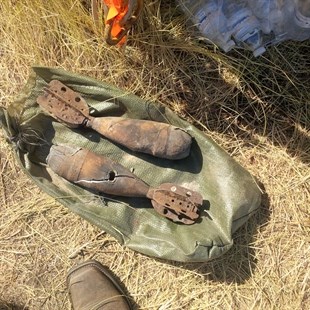
Over 2000 pounds of Unexploded Explosive Ordnance was removed from Madeline Lake this summer, but the work isn't over.
Image Credit: Photo by Don Louis, courtesy of OKIB
September 02, 2014 - 4:39 PM
VERNON - The Madeline Lake range is a swath of sprawling meadow encircled by dense woods and stunning vistas of the North Okanagan. Bears and other wildlife roam the hillside overlooking the two grassy plateaus, located just off Highway 97 northwest of O’Keefe Ranch on the Okanagan Indian Band Reserve. The area is known to hikers, mountain bikers and horseback riders for its beauty, but beneath the surface, the land has a dark and dangerous side.
The Department of National Defence used the land for weapons training during the Boer and World Wars, leaving the range littered with Unexploded Explosive Ordnances (UXOs).
“We either gave a low lease or contributed the lands (to National Defence) with the agreement they cleaned it up after they were done with it,” says Don Louis, band liaison to the defence department.
Louis is part of an initiative between the band and the department to finally clear the range and make it safe for public use. Unexploded ordnances have caused injuries at Madeline Lake (formerly known was Glenemma Range), while three have died at the nearby Goose Lake Range, also on the reserve and being eyed for clearance work.
“Even after 70 years of being in the soil some of them are still very active and very dangerous,” Louis says. “They could potentially take a life again.”
X-Tech Explosive Decontamination Inc. was hired to sweep the Madeline Lake area and a team began removing and detonating ordnances this August. In just two weeks of work on a roughly one-acre hotspot, 2,000 pounds of military debris was collected, including shattered shells and fins as well as 26 live mortars.
Louis anticipates it will take ten years for Madeline Lake and the Goose Lake Range to be 90 per cent cleared. While advanced electro magnetic technology is used to locate items of interest, the site will never be considered 100 per cent cleared.
DND used the land for tank maneuvers, anti-tank weapons training and practice with light machine guns. The most common debris found is 2-3 inch mortars, but crews have also uncovered a 25 pound shell and two containing white phosphorous.
Crews manually dig up ordnances and remotely detonate live explosives from a kilometer away. Sandbags are often placed around the shell during detonation for safety and to prevent shrapnel from scattering. The unexploded ordnances are collected, stored, recorded and destroyed by the defence department.
Every year, school visits are made to increase awareness about affected areas.
“Unfortunately, it’s generally children playing with them, looking at them, curious,” Louis says. “We have signage up and around, but sometimes that’s not enough.”
Other areas used for military training include the Vernon Army Camp, Cosens Bay, Coldstream Ranch and the Commonage. In summer 2013, a diver found a mortar in Kalamalka Lake, and a lawsuit was filed when a developer discovered UXOs could be present on a recently purchased property overlooking Kalamalka Lake.
If you see something that could be an unexploded ordnance, do not touch it. Leave the area and contact 911.
Video Credit: Video by Don Louis, courtesy of OKIB
Unexploded Ordnance detonated at the Madeline Lake Range in Vernon BC.
(Certain photos by Don Louis, courtesy of OKIB.)
To contact the reporter for this story, email Charlotte Helston at chelston@infotelnews.ca or call 250-309-5230. To contact the editor, email mjones@infotelnews.ca or call 250-718-2724.
News from © iNFOnews, 2014